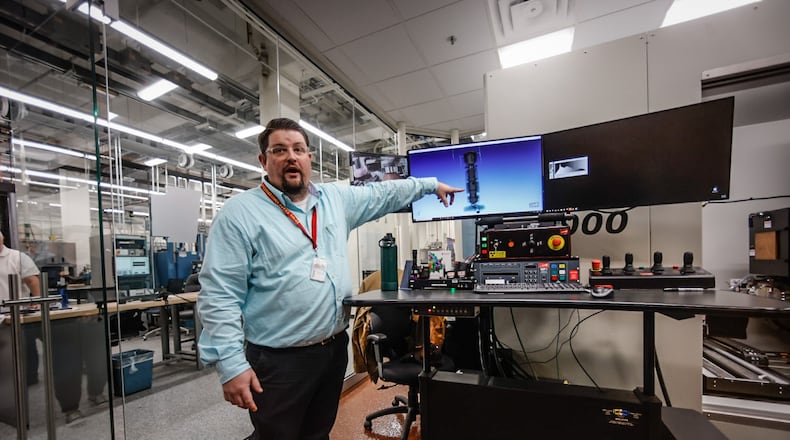The lab is part of AFRL’s Materials and Manufacturing Directorate on Wright-Patterson’s Area B, supporting testing of 3D-printed materials for customers in and outside the Department of Defense.
In one part of the lab, if employees break something, they’re not doing their jobs right, materials engineer Ryan Mooers said Friday.
Credit: JIM NOELKER
Credit: JIM NOELKER
In the rest of the lab, it’s a different story.
“The basic premise of this whole facility — minus this room — is: We break things,” said Senior Materials Engineer Steve Thompson. “Seriously. What Ryan does in here is non-destructive. The type of the work we do out here is destructive.”
Originally built in the mid-1970s, the 6,600-square-foot lab has been graced with brighter lighting and generally brought into the 21st century. Key to the $4.5 million renovation was installation of an additional computed tomography (CT) machine and construction of a suite to house it.
“Computed tomography” refers to a form of computerized X-ray imaging used to look for defects in aerospace-grade materials, from different angles.
This is where engineers learn about a part’s properties in a non-destructive way. If you’ve gone to a doctor and gotten a CT scan for a closer look at a broken bone or an injury — that’s what CT machines do, Thompson said.
Originally, the CT facility had only one machine, but the second unit adds new capabilities.
“It allows us to inspect larger and denser parts and adds different scanning options to produce higher-quality results,” Mooers said.
The idea throughout the whole lab is simple: Make sure a part has the airworthiness and durability the Air Force or other customers need.
“We do mechanical property testing of aerospace-grade materials,” Thompson said. “And that means, we have to test materials for their strength properties and other types of physical properties that go along with the material that go on the aircraft.”
To find out how strong parts are, engineers break them or push them to the breaking point.
Credit: JIM NOELKER
Credit: JIM NOELKER
They have machines that bend, pull and push, seeing how much stress parts can endure. The Air Force and other customers need to know how much these components can take.
Of particular focus are “3-D printed” parts, or parts derived from additive manufacturing — the process of building an object one layer at a time.
The Air Force has found uses for additive manufacturing, but as with any new form of manufacturing, these components need to undergo rigorous testing. 3-D printing has a place in the service’s future, but only if components made that way meet Air Force standards.
“It’s crawl before you walk before you run,” Thompson said.
“It’s a new tool,” materials engineer Edwin Schwalbach said of additive manufacturing. “It’s another tool.”
AFRL Commander Maj. Gen. Heather Pringle recently toured the lab.
“I can tell that you all have a strong working relationship, and that you are there for each other,” Pringle told workers there after the tour. “You are a family.”
The cost of the renovation was covered by DOD Flex-4 funding. The DOD provides Flex-4 funds to enable unique research capabilities.
About $1 million in supplemental AFRL funding financed the CT machine, an AFRL release said.
About the Author



